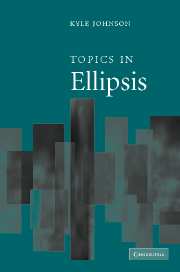Book contents
- Frontmatter
- Contents
- 1 Introduction
- 2 VP Ellipsis and constraints on interpretation
- 3 Direct compositionality and variable-free semantics: the case of Antecedent Contained Deletion
- 4 The view of QR from ellipsis
- 5 Argument Contained Ellipsis
- 6 Variable island repair under ellipsis
- 7 On binding scope and ellipsis scope
- 8 The silent content of bound variable pronouns
- 9 A step-by-step guide to ellipsis resolution
- 10 Shared constituents and Linearization
- Notes
- References
- Index
9 - A step-by-step guide to ellipsis resolution
Published online by Cambridge University Press: 22 September 2009
- Frontmatter
- Contents
- 1 Introduction
- 2 VP Ellipsis and constraints on interpretation
- 3 Direct compositionality and variable-free semantics: the case of Antecedent Contained Deletion
- 4 The view of QR from ellipsis
- 5 Argument Contained Ellipsis
- 6 Variable island repair under ellipsis
- 7 On binding scope and ellipsis scope
- 8 The silent content of bound variable pronouns
- 9 A step-by-step guide to ellipsis resolution
- 10 Shared constituents and Linearization
- Notes
- References
- Index
Summary
Outline of the problem
The topic of this chapter is how VP Ellipsis sentences, such as (1), are represented in syntax.
When John had to cook, he didn't want to [vp].
It is undeniable that an elided VP demands the presence of the “same” VP or VP meaning, but defining the “sameness” is no easy task. One of the two main approaches to this issue is the proform approach, according to which the missing VP is represented as some kind of silent pronoun whose semantic value is retrieved via a meaning recovery strategy similar to nominal anaphora resolution. The advocates for this thesis include Bach and Partee (1980), Rooth (1981), Klein (1986), and most recently Hardt (1993; 1999). The other approach, which I call the LF Structure approach, posits full-fledged syntactic structure for the missing VP at the level of Logical Form (LF). Within this approach, there are two variants. In the “PF-Deletion” analysis, a missing constituent begins its life in the derivation with fully represented structure, which will be deleted in the phonological component but remain intact at LF (cf. Chomsky and Lasnik 1993; Fox 2000). The other variant, including Fiengo and May (1994), treats the missing material to be truly missing at the beginning but copied from its antecedent at LF. The debate between the Proform and the LF Structure camps has a long history and is still ongoing.
- Type
- Chapter
- Information
- Topics in Ellipsis , pp. 210 - 228Publisher: Cambridge University PressPrint publication year: 2008
- 3
- Cited by

